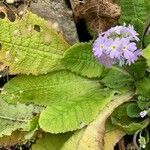Herbs perennial, encircled at base with broadly ovate (1.5--4 X 1--2 cm), subfleshy bud scales. Leaves forming a rosette; petiole broadly winged, indistinct to nearly as long as leaf blade; leaf blade oblong to oblanceolate, 3--15 X 1.5--4 cm, enlarging to 20 cm or longer at fruiting, abaxially pubescent along veins or subglabrous, sometimes white or yellow farinose at fruiting, adaxially puberulous or glabrescent, base attenuate, margin denticulate, apex rounded to obtuse. Scapes 5--30 cm, elongating to 45 cm in fruit, glabrous or puberulous, efarinose or farinose in upper 1/2; umbels capitate, many flowered; bracts numerous, lanceolate, 5--10 mm, base overlapping and slightly gibbous. Pedicel 1--5 mm. Flowers heterostylous. Calyx narrowly campanulate, 5--10 mm, farinose or minutely glandular, parted to middle or below; lobes often tinged with purple, oblong-lanceolate, ciliolate. Corolla purple to pinkish purple, rarely white, with a yellow eye, exannulate; tube 0.8--1.2 cm; limb 1--2 cm wide; lobes obovate, deeply emarginate. Pin flowers: stamens ca. 3 mm above base of corolla tube; style 6--7 mm. Thrum flowers: stamens ca. 6 mm above corolla tube; style 1.5--2 mm. Capsule subglobose, shorter than calyx. 2n = 22, 32, 34, 44, 22 + 5f.
More
A herb. It grows 20-30 cm high and spreads 25-45 cm wide. It is covered with white hairs that brush off. The flower buds are round and at ground level. These stretch to 23-30 cm on sturdy short stems. The flowers are round and open in a range of colours. They can be lilac, red or purple.
It is a temperate plant. It grows well beside water. In Pakistan it grows between 1,300-4,300 m altitude. It grows near melting snow. It Tibet it grows in open forests and grassland between 1,500-4,100 m above sea level. It suits hardiness zones 5-9.
More
Shrubberies and open slopes in moist situations, often along drains, 1500-4500 metres.

